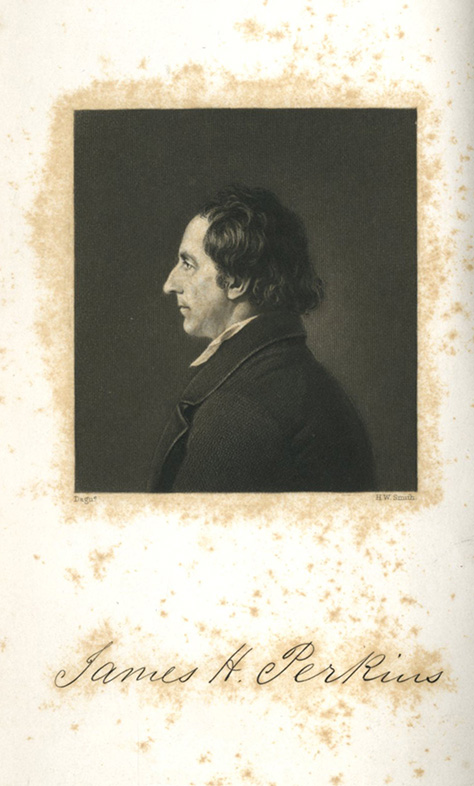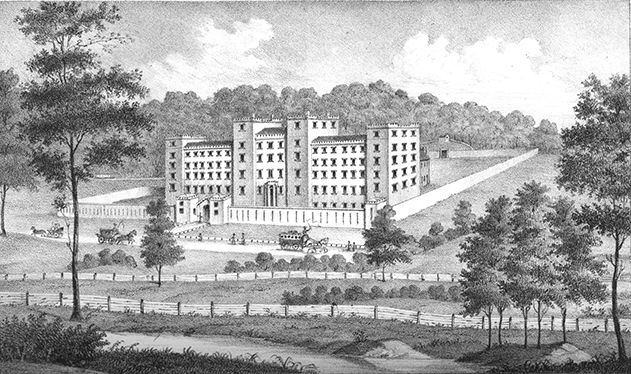 Before the House of Refuge opened in 1850, there was no institution serving juvenile criminal offenders in Cincinnati. Juvenile offenders were housed with adults in the Hamilton County jail. In the late 1830s, a movement began in Cincinnati to reform the penitentiary system and a man named James Handaysd Perkins took part in this movement. Although Perkins did not live long enough to see it, he had an important role in the start of the juvenile criminal justice system and social services in Cincinnati.
Before the House of Refuge opened in 1850, there was no institution serving juvenile criminal offenders in Cincinnati. Juvenile offenders were housed with adults in the Hamilton County jail. In the late 1830s, a movement began in Cincinnati to reform the penitentiary system and a man named James Handaysd Perkins took part in this movement. Although Perkins did not live long enough to see it, he had an important role in the start of the juvenile criminal justice system and social services in Cincinnati.
Perkins was born in Boston and moved to Cincinnati as a young man in 1832. He came from a well-to-do family and was a talented writer and speaker, but he seemed to struggle to find his place in life. He suffered from some health problems and also possibly from some mental health issues.[i] He arrived in Cincinnati in search of a quieter life and with hopes of purchasing land for a farm, but instead he quickly became an up and coming member of society. He began studying law under his friend, Timothy Walker, and joined a group of affluent New Englanders already living in Cincinnati. Perkins even met his wife, Sarah Elliot of Connecticut through his social circles. Even though life seemed to be going well for him, Perkins quickly became disillusioned with the law and attempted a variety of different careers from farming to establishing a milling and tool manufacturing business.
Perkins would leave his strongest legacy, though, on the intellectual life of Cincinnati. He was a supporter of the Cincinnati Law Library, the Ohio Mechanics Institute, the Cincinnati Astronomical Society, Cincinnati College, the Western Academy of Natural Sciences, and the Cincinnati Historical Society. He published essays and poems in both Cincinnati publications and Eastern journals. He also served as an editor for several magazines and newspapers. In 1840, he published a book on history and geography entitled Annuals of the West. Perkins was also very interested in education, especially the education of women. He was a member of the Western Literary Institute and College of Professional Teachers. He even opened a school for young women in his home with a curriculum he designed himself.
In 1839, Perkins took a position as a minister at large with the First Congregational Church in Cincinnati and it is in this position that he learned about the lives of the poor in Cincinnati. Perkins felt the best solution to poverty was finding employment for those who were unemployed, so he focused much of his time doing this. (Vitz, 45) Perkins opened an office where he connected unemployed people with work. Out of this work, the Cincinnati Relief Union was established and Perkins served as President from its start until his death (Channing, 122).
After his first-hand experience with the poor, Perkins began advocating “broad institutional reform” for public education and prisons and began pushing for a House of Refuge for the city of Cincinnati (Vitz, 45). Perkins stressed the need for a place where “all boys and girls violating that law may be sent, there to be educated, reformed, and made worthy of society, and saved from a life of sin” (Channing, 131). Stressing the difference between adults and children who committed crimes, Perkins advocated for reform of the young. He felt that the House of Refuge system could provide this reform. He wrote that in the House of Refuge system “boys and girls….are received and truly reformed; fifty in a hundred among those who have left them are known to be industrious and upright, — not five of whom would have been saved from crimes and ruin in any other way, so far as can be judged” (Channing, 132). Perkins also saw a House of Refuge as consistent with his Christian beliefs calling it “one of the few direct applications of Christian principle to the practical institutions of society” (Perkins, “House of Refuge,” 125).
Although Perkins was among the first Cincinnatians pushing for the establishment of a House of Refuge, he did not live long enough to see the opening of Cincinnati’s House of Refuge. His life-long struggles with his physical and mental health came to end in December of 1849 when he committed suicide. He left behind his wife Sarah, five young children, and a legacy of working for solutions to Cincinnati’s social problems.
[i] In his article, “The Troubled Life of James Handasyd Perkins,” Robert Vitz suggests that Perkins may have struggled with depression and self-esteem issues from a young age.
References:
Perkins, J.H. (James Handasyd). 1843. House of Refuge. The Western Law Journal. 1,no. 3: 125. https://search.proquest.com/docview/126835400?accountid=2909 (accessed 12 February 2019).
Perkins, J. H. (James Handasyd)., Channing, W. H. (William Henry). 1851. The memoir and writings of James Handasyd Perkins. Vol. 1 Cincinnati: Trueman & Spofford. https://hdl.handle.net/2027/nyp.33433076014608 (accessed 12 February 2019). Available in ARB in 2 volumes: RB F495 .P34y
Vitz, Robert C. 1995. The Troubled Life of James Handasyd Perkins. Queen City Heritage 53, no. 3: 40-48. http://library.cincymuseum.org/starweb/journals/servlet.starweb (accessed 12 February 2019).


